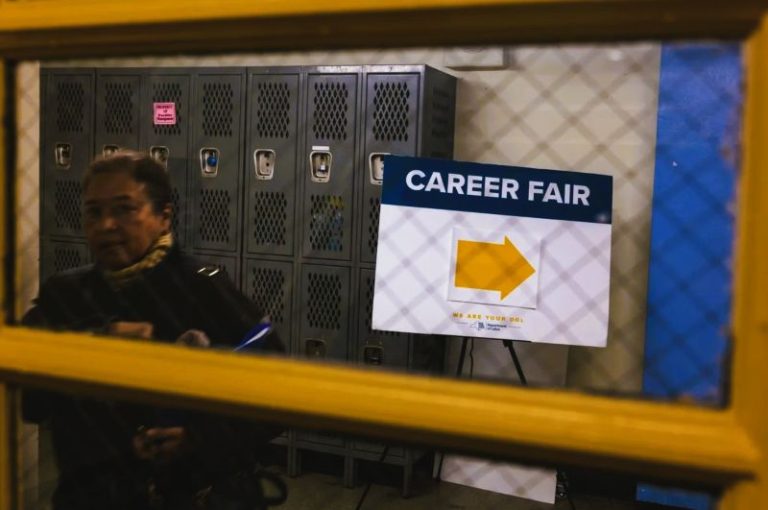
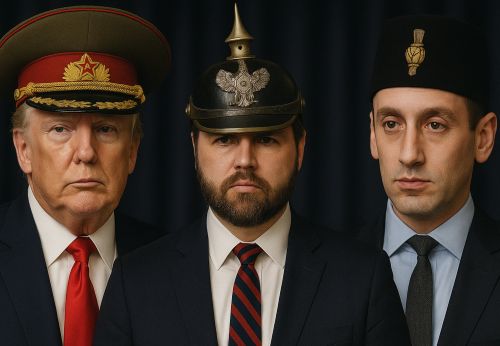
History offers no shortage of warnings about how democracies decay: not through sudden coups, but through the slow normalization of concentrated power.

By Matthew A. McIntosh
Public Historian
Brewminate
Introduction
When Donald Trump chose J.D. Vance as his running mate, it was more than a political partnership; it was the fusion of shared instinct and ambition. Once a vocal critic who compared Trump to Hitler, Vance has since reshaped himself into one of Trump’s most loyal defenders, a transformation that speaks less to reconciliation than to submission. His trajectory from dissent to devotion mirrors a broader pattern within the Republican Party, where ideological boundaries have collapsed into obedience.
Inside this new administration, the influence of Stephen Miller looms large. Miller, architect of Trump’s most hardline immigration policies, is now poised to wield near-total authority over domestic governance. His post-liberal worldview, informed by the belief that liberal democracy has failed, meshes seamlessly with Vance’s own embrace of hierarchical order and “common good” politics, a movement critics describe as authoritarian in clerical clothing. Together, they form a triad of power unified by loyalty and untroubled by limits.
For a nation still defined by its experiment in checks and balances, the Trump-Vance-Miller alliance may prove the most consequential test yet, not merely of political endurance, but of democracy’s capacity to resist its own internal undoing.
From Critic to Loyalist: J.D. Vance’s Political Evolution
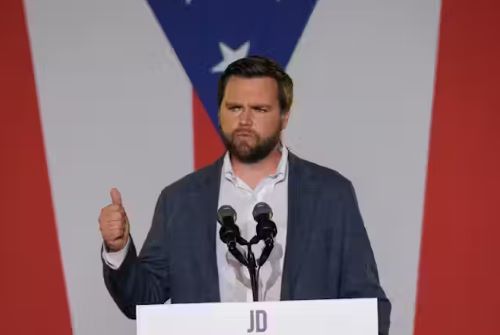
In 2016, long before his ascent to national power, J.D. Vance was one of Donald Trump’s most pointed conservative critics. In private messages and public interviews, he dismissed Trump as “an idiot” and “reprehensible,” even warning friends that the future president could become “America’s Hitler.” Those remarks were made when Trump announced Vance as his vice-presidential pick, noting the stunning reversal of tone that followed once Vance’s political ambitions grew.
The author of Hillbilly Elegy, once hailed as a voice of rural disaffection, had originally cast Trumpism as a dangerous form of grievance politics. But by 2022, Vance had rebranded himself as one of Trump’s fiercest advocates, adopting his rhetoric on immigration, “deep-state” conspiracies, and elite corruption. A review of his intellectual journey described a man who “reconstructed his worldview to align with Trump’s populism,” finding in it a vehicle for his own theory of post-liberal order.
That evolution was not merely ideological; it was opportunistic. Trump’s selection of Vance represented “a doubling-down on authoritarian instincts” rather than an attempt at moderation. Vance’s earlier moral revulsion had given way to a conviction that Trump’s strongman style was not only necessary but righteous, a form of executive discipline over a decadent system.
This metamorphosis reveals more than personal ambition. It exposes a governing philosophy that prizes obedience over principle. In Vance’s acceptance of Trump’s dominance, and in his own rhetoric about the need to “reorder power” toward moral hierarchy, there lies a quiet endorsement of the very authoritarian model he once feared. His political rebirth completes a circle that began in warning and ends in allegiance, a loyalty forged not in persuasion, but in surrender.
The Selection as Vice President: What It Signals
Overview
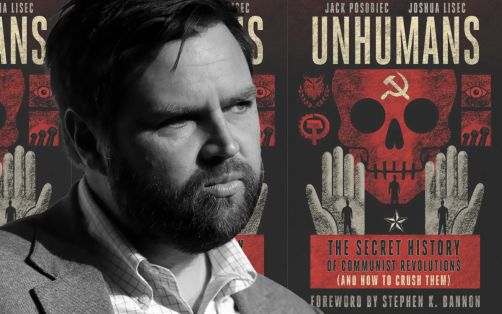
The announcement on July 15, 2024, that J.D. Vance would join Donald Trump’s ticket as vice-presidential pick marked more than the usual strategic concession of geographic or demographic balance. It offered a window into the governing model the pair intend to pursue.
A Deliberate Message to the Base
Vance’s elevation signals a pivot toward a ticket driven by ideological consolidation and executive energy rather than moderate compromise. Analysts noted that his selection “signals a more aggressive protectionist trade policy” and a move away from standard Republican technocratic governance. Vance, a U.S. Senator from Ohio with a relatively brief national tenure, was chosen despite earlier criticisms of Trump, underscoring the priority of loyalty and alignment over internal dissent.
The Strategic Calculation
From a campaign standpoint, the pick served multiple functions. It tapped into the Rust Belt/industrial-heartland sentiment through Vance’s Ohio roots; it reinforced Trump’s branding as the champion of “forgotten” Americans; and it signalled that the administration would continue its populist, nationalist trajectory rather than shift toward the center. Vance’s speech on July 17 emphasized his origins “in a neglected industrial Ohio town” and a promise to fight for the working class.
What it Means for Governance and Power Dynamics
By choosing someone with minimal independent political footprint but strong allegiance, Trump appears to be consolidating a team more oriented toward execution than debate. Vance is expected to act as the president’s “eyes and ears” in Congress and in domestic policy, ensuring the agenda aligns closely with Trump’s rather than running on a parallel track of his own.This dynamic raises questions about the role of the vice presidency as a check or balance, and whether the pick signals a preference for compliant partnership rather than independent oversight.
Policy Implications
Vance’s background and revealed policy stances hint at the direction of the administration: more protectionist trade measures, tougher immigration postures, and a willingness to deploy executive power aggressively. For instance, his endorsement of broad antitrust enforcement and support for the Federal Trade Commission’s chair Lina Khan suggest readiness to challenge corporate power from the right. In foreign affairs, his isolationist/realist leanings offer a departure from conservative interventionist norms.
Why This Signals More Than a Normal Ticket Choice
In typical modern U.S. politics, vice-presidential selections are partly about balance, partly about succession planning, and partly about shoring up campaign strategy. In this case, the choice of Vance, and his previously public denunciations of Trump, points to something deeper: a political culture where ideological alignment and subordination to a strong leader matter more than previous critiques or independent standing. For an administration already scrutinized for its populist and nationalist style, Vance’s elevation is a further confirmation that the priority is consolidation of power over pluralistic governance.
Stephen Miller: The Authoritarian Architect
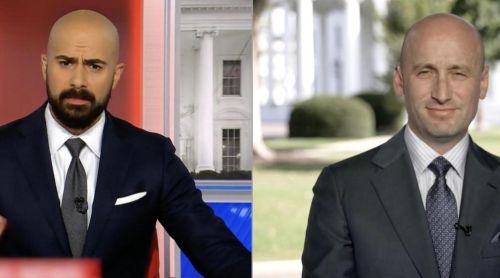
If Vance represents loyalty in public form, Stephen Miller embodies ideological control behind closed doors. Once a relatively obscure Senate aide and speechwriter, Miller emerged during Trump’s first administration as the engine of the president’s most extreme immigration and nationalist policies. His influence has only grown since Trump’s return to the White House, wher, he has been granted near-total latitude to shape policy across departments under the banner of “law and order.”
Miller’s political philosophy rejects liberal pluralism in favor of a vision that prizes unity, obedience, and cultural purity. A report from Zeteo describes him as “a bureaucratic revolutionary,” one who understands that real power lies not in rhetoric but in the machinery of enforcement. His signature policies (family separations, mass deportations, and expanded detention systems) have been widely condemned by civil-rights groups as violations of international norms. Yet Trump has publicly praised Miller for his “toughness,” a quality he now sees as essential to national restoration.
Miller has built an internal infrastructure to sustain his influence. Through his group, America First Legal, he had launched a steady stream of lawsuits and policy proposals aimed at dismantling diversity initiatives and restricting immigration. The Independent reported that California Governor Gavin Newsom called Miller’s ideology “openly fascist,” warning that his proximity to the Oval Office again poses a threat to democratic guardrails.
Miller’s return to direct policy authority has revived fears that the second Trump administration will institutionalize his approach. His project is not simply political but moral, to replace liberal democracy with what he sees as an ethical order rooted in discipline and exclusion. In that context, his alignment with Vance is no coincidence. Both men are products of an intellectual milieu that views democracy’s messiness as weakness and hierarchy as salvation. Together, they transform Trump’s instinct for domination into something more systematic, a theory of governance designed for permanent control.
Why the Combination Is Dangerous
Donald Trump’s partnership with J.D. Vance and Stephen Miller is more than a campaign arrangement, it represents an ideological convergence around hierarchy, purity, and control. Each man amplifies the others’ instincts. Trump provides the populist charisma and appetite for domination. Vance offers intellectual justification for executive moralism, the idea that a strong leader must “reorder power” for the sake of the nation’s virtue. Miller delivers the bureaucratic machinery to make that vision operational, one policy memo and one agency directive at a time.
Analysts across the political spectrum have warned that this alignment signals a movement from populist grievance toward systemic authoritarianism. Trump’s selection of Vance “doubles down on authoritarianism,” choosing not a counterweight but a disciple. Vance’s acceptance of that role, after having called Trump “reprehensible” and compared him to Hitler , underscores how power reshapes conviction. He is not merely following orders; he has come to see obedience as a political virtue.
Stephen Miller’s expanded reach within the White House intensifies those concerns. Trump has given Miller carte blanche over immigration and internal security, authority extending far beyond his previous portfolio. Combined with Vance’s post-liberal ideology, this creates a feedback loop: a presidency reinforced by loyalists who view constraint as weakness and dissent as betrayal.
The danger lies not only in the personalities but in the structure of governance they envision. Miller’s technocratic command of enforcement, paired with Vance’s philosophical rationalization of hierarchy, supplies Trump’s authoritarian tendencies with both muscle and moral language. The three together form a self-sustaining ecosystem of loyalty (the populist, the intellectual, and the enforcer) bound by a shared conviction that the liberal order has failed and must be replaced by one strong will.
For those who still see democracy as dependent on friction, argument, and compromise, the emerging Trump-Vance-Miller alliance suggests a government allergic to all three. It is not the noise of politics they seek to quiet, but the capacity of institutions to resist.
Broader Implications for the Republic
The fusion of Trump’s populist charisma, Vance’s moral authoritarianism, and Miller’s bureaucratic precision forms a governing trinity that tests the limits of American democracy itself. The United States has long relied on internal restraint, the assumption that even powerful figures will respect norms, heed institutional checks, and tolerate dissent. This new configuration rejects that premise outright.
At its core lies a shared conviction that democracy’s pluralism is a flaw to be corrected, not a value to be preserved. Vance’s embrace of post-liberal thought reframes freedom as order and equality as decadence. In this worldview, the state’s role is to enforce moral clarity rather than protect individual rights. When paired with Miller’s drive to consolidate executive power, it transforms governance into a moral crusade: the pursuit of purity through control.
The institutional consequences could be profound. With a vice president defined by deference rather than independence, the executive branch faces the real prospect of functioning as a closed loop, decisions made by a small, ideologically aligned cadre and implemented through a compliant bureaucracy. Trump’s willingness to surround himself with subordinates who validate rather than challenge him, documented across his presidencies, magnifies the danger of unaccountable governance.
This concentration of power also corrodes the broader civic fabric. A government animated by moral absolutism and enforced conformity leaves little room for dissenting faiths, minority communities, or journalistic scrutiny. When political virtue becomes synonymous with loyalty to the leader, truth itself bends to narrative. What emerges is not the traditional American tension between left and right, but a deeper conflict between democracy and hierarchy.
The Trump-Vance-Miller alliance may thus be remembered less as a political campaign than as an experiment in authoritarian efficiency, a demonstration of how ideology, intellect, and infrastructure can combine to erode the republic from within. The question that remains is not whether the system can survive them, but whether it can still recognize the danger before it’s too late.
Conclusion
The alliance of Donald Trump, J.D. Vance, and Stephen Miller marks a defining moment in America’s political evolution, a moment when personal loyalty, ideological zeal, and executive force have fused into a single governing philosophy. It is not simply a return of Trumpism; it is its refinement. What began as a populist rebellion against elites has hardened into a movement that sees dissent as disloyalty and pluralism as decay.
Vance’s journey from moral critic to devoted acolyte captures how power transforms principle into expedience. His past warning that Trump resembled Hitler now lingers as a haunting echo, a judgment he himself has chosen to outlive. Miller’s ascension, meanwhile, gives that moral surrender institutional form, embedding authoritarian logic deep within the state’s administrative machinery. Together, they lend Trump’s instinct for domination both the philosophical justification and the bureaucratic skill it previously lacked.
The danger is not theoretical. It is structural and immediate. A vice president who defines virtue as obedience, a policy chief who envisions the executive as moral arbiter, and a president who prizes loyalty above law, together they dismantle the very premise of republican governance. The Founders imagined ambition would counteract ambition; they did not imagine ambition would dissolve into devotion.
History offers no shortage of warnings about how democracies decay: not through sudden coups, but through the slow normalization of concentrated power. Whether the United States heeds those lessons will depend on whether citizens recognize that the erosion of liberty rarely begins with crisis. It begins with comfort, the quiet acceptance that one man, or one vision, can save the nation if only the rest of us stop asking questions.
Originally published by Brewminate, 10.20.2025, under the terms of a Creative Commons Attribution-NonCommercial-NoDerivatives 4.0 International license.

